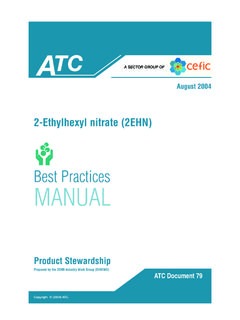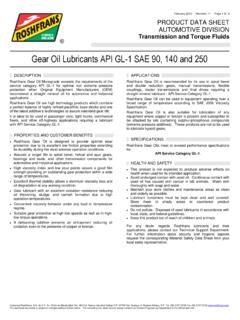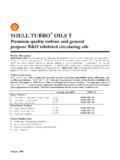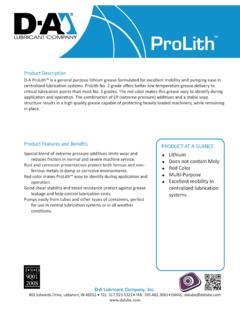Transcription of Introducing ATC Document 118 Lubricant …
1 Introducing ATC Document 118 Lubricant additives : Use and BenefitsLubricant additives : Use and BenefitsPurpose Introduction to ATC; organisation and objectives Explains the contribution Lubricant additives make to industry, consumers and the environmentScope Automotive engine oil additives Europe (EU-28)Targetaudience Regulators, Educators, Employers Anyone interested in our industryAvailability Online HardcopiesSister Document ( Document 113) also Available covering Fuel AdditivesLUBRICANT additives : USE AND BENEFITSSLIDE 2 2017 ATC (Additive Technical Committee). All rights reservedATCM ember CompaniesSLIDE 3 Lubricant additives : USE AND benefits 2017 ATC (Additive Technical Committee). All rights reservedLubricant Additive Industry Profile in 2016 World-wide the industry spends about 600 million/annum on research and development, of which 240 million is spent in Europe (EU-28).
2 World-wide the industry has a turnover of about 11,700 million of which the European market is about 3,600 million. The industry employs directly about 3,800 people in Europe and about 12,000 globally. The industry operates more than 35 research and development establishments and manufacturing sites in Europe, and more than 100 globally. The petroleum additive industry in Europe is a major additives : USE AND BENEFITSSLIDE 4 2017 ATC (Additive Technical Committee. All rights reservedDocument 49 First published 1993 Document 118 2016 Updated 2007 Document 118 issued in 2016 SLIDE 5 Lubricant additives : USE AND benefits 2017 ATC (Additive Technical Committee). All rights reservedJoerg WilminkAfton ChemicalOEM Relationship Manager for heavy duty engine oil solutions.)
3 Mechanical engineer and business economist with 20 years of automotive teamRay CalderLubrizolGlobal business manager and former chairman of ATC. Chemist with over twenty years of experience in the additive JonesLubrizolFormulator for passenger car engine with 10 years of experience in the additive BerrymanInfineumIndustry Liaison Advisor. Chemist with 30 years of experience in the Lubricant additive HartgersChevron OroniteFormulator for passenger car engine chemist with 10 years of automotive 6 Lubricant additives : USE AND benefits 2017 ATC (Additive Technical Committee). All rights reservedHistoryof Additive DevelopmentEarly1930s to current developmentsChemistry of Lubricant AdditivesChemical descriptionof main additive classes; dispersants, detergents, anti-oxidants, anti-wear components and friction modifiersHealth, Safety andthe EnvironmentChemical Regulations (REACH) and additive contribution to exhaust emission reduction; Disposal and re-refining ofused oilBenefitsof Lubricant AdditivesAdditive contribution tofuel economy and CO2reduction; Lubricationengineering for durability and engine protectionSLIDE 7 Lubricant additives : USE AND BENEFITSMain topics 2017 ATC (Additive Technical Committee).
4 All rights reservedHistory of Additive DevelopmentEarly 1930s to Current Additive development is a key activity of ATC members and is driven by new Lubricant specifications, to meet higher engine oil performance for new engine designs and increasing fuel economy demands. Recent innovations do focus on ashlessadditives and friction 8 Lubricant additives : USE AND benefits 2017 ATC (Additive Technical Committee). All rights reservedAdditive ClassFunction& Mode of OperationDetergentsDetergents are surface active. Deposit precursors are trapped within the detergent micelle keeping them in larger particle agglomeration and hence oil thickening. Effective at stabilising soot produced by diesel wear of metal surfaces by reduction of friction during boundary lubricationby forming low shear films on metal surfaces.
5 ZDDPs are by far the most effective oxidants/ Anti corrosionPrevent oil thickening andbuild up of corrosive acids by disrupting the chain propagation steps of the oxidative reaction, acting as either peroxide decomposers or free radical foaming by reducingsurface tension of air bubbles causing them to ModifiersReduce power loss by forming films between metal surfaces during boundary Point DepressantsReduces the lowest temperature at which an oil will pour or flow when cooled. Inhibit the formation of interlocking wax crystal ModifiersHighmolecular weight polymers which increase oil viscosity at higher temperature, allowing acceptable engine operation over a much wider temperature rangeChemistry of Lubricant additives Document 118 describes each of the major classes of additive 17.
6 Illustration of Boundary LubricationSLIDE 9 Lubricant additives : USE AND benefits 2017 ATC (Additive Technical Committee). All rights reserved Performance additive packages are complex mixtures of individual components. Formulation expertise is required to ensure synergistic and adversarial effects are balanced. Document 118 presents an update of typical formulations for both PCMO and HDEO member survey-Weighted averages-Major component categories-Constituent additive componentsFormulation of Lubricating OilsSLIDE 10 Lubricant additives : USE AND benefits 2017 ATC (Additive Technical Committee). All rights reservedFormulation and Market Trends A study was conducted providing insights to current formulation and market trends. The Document presents rationale for those trends including-Market size; EU-15 expansion to EU-28-Changes in formulation strategies due to emission legislation-Growth in lower viscosity lubricants -Extended oil drain intervals-Use of alternative fuels EU-28 sales of major additive classes show growth in PCMO, in particular for dispersants and Antioxidant Metal detergent ZnDTP AshlessdispersantSLIDE 11 Lubricant additives : USE AND benefits 2017 ATC (Additive Technical Committee).
7 All rights reservedHealth, Safety and Environment This update of Document 118 includes a brief summary of the work done by the ATC / ATIEL REACH Working Group in the HSE section covering-Generic Exposure Scenarios-Specific Environmental Release Categories Impact of environmental legislation on Lubricant without hazardous chemistries, , Barium-Reduction of Sulphur, Phosphorus and Ash Engine oil consumption and rate varies by country Re-refining and re-use of engine oils-Re-refined base oils can be classified as API Group I, II or European Chemicals AgencyCollection rate (%) by countrySLIDE 12 Lubricant additives : USE AND benefits 2017 ATC (Additive Technical Committee). All rights reserved Significantly enhanced section on the benefits of Lubricant additives included in this update of the Document covering-CO2reduction and fuel economy-Durability and protection-Compatibility with alternative fuels- additives as engine design components CO2 Reduction EU Exhaust Emission Regulations including penalties for non-compliance are in place.
8 lubricants with innovative additive technology can reduce engine friction to improve fuel economy of Lubricant AdditivesSLIDE 113 Lubricant additives : USE AND benefits 2017 ATC (Additive Technical Committee). All rights reserved Fuel Economy Reducing energy loss due to friction in the engine is key to improving the fuel economy performance of vehicles; this has driven the trend towards lower viscosity oils. Durability and Protection Increasing power output at higher-load engines combined with longer drain intervals requires additive technology to protect and form anti-wear layers on of Lubricant AdditivesSLIDE 14 Lubricant additives : USE AND BENEFITSZDDP tribofilmon metal test piece 2017 ATC (Additive Technical Committee). All rights reserved Bio-Fuel compatibility Biofuel dilution in engine oils requires additive technology which prevent viscosity increase and sludge formation.
9 Lubrication Engineering Lubricant additives are now considered as lubrication engineering design components enabling significant advances in engine of Lubricant AdditivesSLIDE 15 Lubricant additives : USE AND BENEFITSF actors19962014 Change and Gasoline-15% smallerPower148 HP220 HP+48% more powerPower Density64 HP/litre110 HP/litre+72% power densityEmissionsEuro IIEuro VIReducedEmissionsWeight1147 kg1407 kg+23% heavier0-100 sMore performanceTable 12. Example of Changes in Passenger Car OEM Hardware 2017 ATC (Additive Technical Committee). All rights reserved First edition produced in 1993 and revised in 2007. Aims to show the contribution Lubricant additives make towards the automotive industry, the consumer and the impact on the environment.
10 This edition (2016) provides an update on recent additive developments and contains recent data on the Lubricant market. Describes the chemistry and functions of Lubricant additives , as well as their role in the development of advanced engine systems. Product health and safety aspects are reviewed. The significant benefits of additive technology towards engine operation and end-users are explored. Useful overview Document for anyone with an interest in the Lubricant additive business. 2017 ATC (Additive Technical Committee). All rights reservedLubricant additives : Use and BenefitsLUBRICANT additives : USE AND BENEFITSSLIDE 16 Acknowledgments The Update team would like to acknowledge the expertise and support of the following people without whom the update would not have been possible:-Ian Field, ATC Secretary General.








